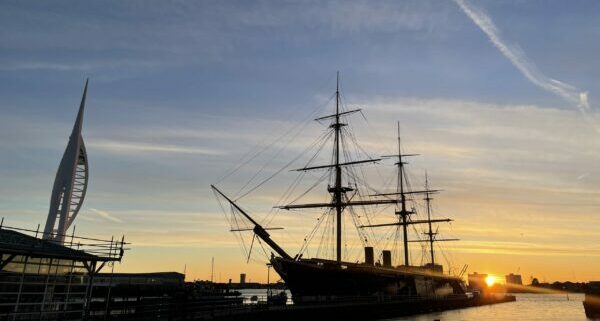Excerpt from article written by Martin Conway, The Naval Architect, April 2025.
Header image – RRS Discovery at sunset by John Pow.
While the classification of operational ships can be a challenging task, the compliance required to ensure safe navigation is at least well-known, in most cases. However, when it comes to static floating ships, the regulations become much more ambiguous. As John Monasta, associate director at maritime engineering firm Beckett Rankine, explains, the first key question to ask may be: “When does a ship stop being a ship and become a floating building?”
Data shared by National Historic Ships UK suggests that there are more than 2,000 historic ships around the UK, either moored, under restoration or no longer afloat. As Monasta points out, there is a misconception that, once a retired or historic ship has been moored – and now functions as a tourist attraction, a floating museum or a bar or restaurant – the need to conduct regular stability assessments is diminished.
As a naval architect and engineer by trade, Monasta was keen to raise awareness of the need for proper stability checks for floating static vessels. However, he soon found he was dealing with a regulatory “grey zone”.
For example, operational ships comply with the standards set by IMO, their local maritime authority (such as the MCA in the UK) and the classification societies. Structures technically classed as ‘buildings’ in the UK, meanwhile, come under the Construction (Design and Management) 2015 (CDM 2015) regs, introduced 10 years ago to ensure that structures are safe to build and use. Static floating ships, though, tend to fall uncomfortably between both stools.
“There isn’t enough understanding of the potential risks for static vessels,” Monasta continues. But there can be advantages to this lack of distinct regulation in the UK. Without a regulatory body dictating a strict set of assessment rules for static floating vessels, the maritime heritage sector can take a risk-based approach to its asset management.
In turn, “this offers the freedom to put the historic fabric of the vessels at the core of their conservation”. The newly released stability guidance offers practical solutions without compromising the individual vessel’s heritage.
So, in collaboration with National Historic Ships UK and supported by funding from Lloyd’s Register Foundation, Monasta and Beckett Rankine have co-launched the ‘Don’t Rock the Boat’ project, focusing on static floating ship stability and related risk mitigation.
This initiative has culminated in the publication of the UK’s first-ever set of guidelines specifically tailored towards these ship types. Monasta adds that the plan is to use this guidance “as a foundation for conversations with our clients”, and as a useful resource for contractors and service providers, particularly in addressing the often-confusing overlaps between maritime and offshore regulations, UK Common Law requirements and other grey areas related to liability and insurance.
Read the full article [PDF, free access]



